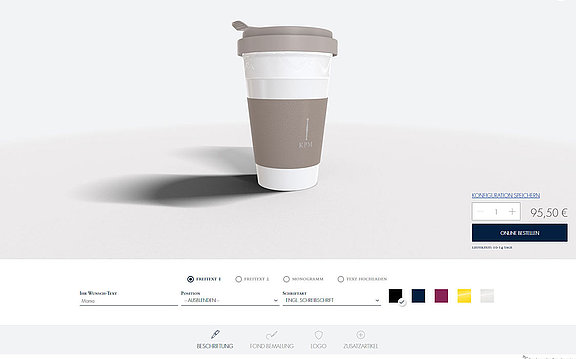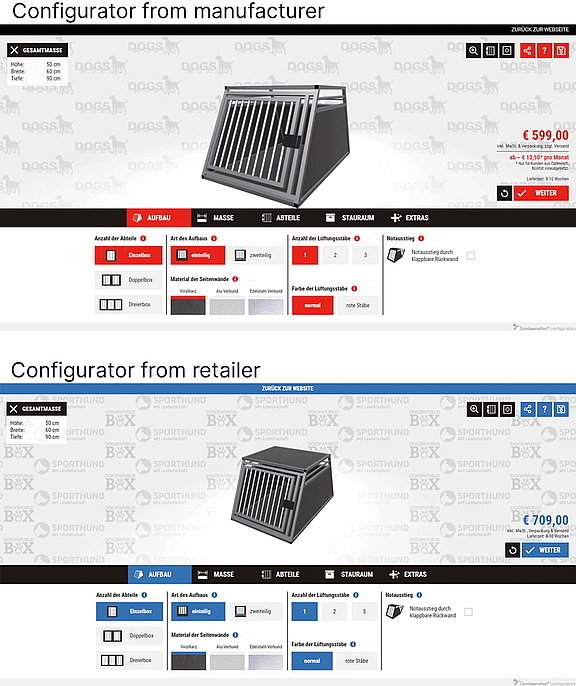Can my retailers also use the 3D configurator?
Author: Matthias Baumgartner
Many companies have a network of distributors who retail their products. However, it can be a challenge to provide these retail partners with the right product knowledge and up-to-date information so that they can sell the manufacturer's products in the best possible way. In this context, a 3D configurator can serve as a useful tool.
Can a 3D configurator also be used by retailers?
If this is web-based, as is the case with Combeenation, there are many ways for retailers to use a configurator from the manufacturer or to integrate it into their sales processes. In the following, we will go into detail about the individual possibilities:
Presentation of the product at the point of sales
It is simply impossible for a retailer to physically present all the characteristics, variations, colors, etc. of a product. Think for example of the product "bed" with different sizes, wood types, headboards, etc,...The corresponding showroom would have to be a hall to show all possible combinations. A 3D configurator can be used effectively on a screen as a POS solution to show all the possibilities of the retailer with a few clicks. The customers themselves also have the possibility to select the product for their wishes and needs.
Retailer portal
Manufacturers often offer digital services to their partners. A configurator can be easily integrated into this landscape. The login data in the retailer portal can be taken over by the configurator so that, for example, dealer-specific settings, prices, options, etc. can be displayed. The dealer then has the direct option of creating and saving any number of configurations for his customers. In addition, parts lists for production can be derived from this information, for example, or inquiries and orders can be passed on to the manufacturer.
White Labeling
White labeling is a concept in which a product or service is produced by a manufacturer but is not offered under its name. Instead, the product or service is sold under a different brand. Thus, when a configurator is used, it must of course be possible to adapt it to the respective branding of the retailer. This is also possible if the configurator design is prepared for this and elements such as colors, fonts and logos can be quickly exchanged.
Connection to online store
More and more retailers rely on online stores to sell their products. The configurator can be placed at the desired locations in the online store. The finished configuration is transferred to the shopping cart of the respective store system with the desired parameters.
Technical requirementThe configurator can be integrated on any website and in all store systems via iFrame. In addition, there are already plug-in solutions for the connection to store systems to make the connection as simple as possible. Important: Depending on the product area, many retailers have a high proportion of mobile accesses (first touchpoint). Here, it must be ensured that the configurator is also optimized for smartphones. Even with complex products, it is necessary to pick up the customer at this point in order to build trust and facilitate the purchase decision.

Are 3D configurators the future of retail?
Today's shoppers use both online and offline sales channels to make their purchasing decisions. However, it is becoming increasingly difficult to make an informed decision because the online offering is often confusing and there is a wide range of information available from different sources. In addition to the official product pages of manufacturers and dealers, customers can access testimonials, YouTube videos, forums and much more to form a comprehensive opinion. How, therefore, can the use of a configurator improve the shopping experience to facilitate customer decision-making?
- Customers expect relevant information to make their purchase decision. A good configurator is also an advisor. In the configurator, information in text, images and videos can be easily implemented and accessed as needed.
- Prices: Customers want to know what the product costs. If a retailer does not offer prices, customers will look elsewhere. Prices are displayed in the configurator. Depending on the user's selection, this changes in real time. The customers themselves thus recognize the transparent pricing and the logic behind it. This creates trust.
- Personalized products: Through personalization, the wishes and needs of customers can be specifically addressed. Customers are often willing to pay more for a personalized product. A visual configurator can display all the possibilities in real time: Color requests, size to measure, upload of lettering and logos that can be placed on the product, ...

- Relationship: A configurator can bring a personal touch to the relationship between the customer and the company by giving customers the opportunity to design the product according to their wishes and needs. This makes customers feel valued and taken seriously. If the configurator is easy to use and offers a good user experience, this can also help them to perceive the company positively and remain loyal to it (brand loyalty effect).
Whether configurators are the future of retail depends on the industry and the specific needs of the customer:inside. But it is clear that the use of configurators offers the opportunity to create a personalized shopping experience and thus gain competitive advantage.
What you should know about using configurators at your retailers.
How can you ensure that the retailers sell your products best and most like them (many retailers sell several manufacturers of certain product groups)? Salespeople sell the most products for which they have ordering competence and the corresponding knowledge. Imparting this knowledge often requires regular training and the corresponding resources, because dealers would have to spend this training effort for each of their manufacturers. Here in particular, the configurator is an important service for passing on information, options and current changes to dealers quickly and easily. The retailer no longer needs specially trained personnel for his product, but uses the configurator as a support in the consultation.
Another added value is the elimination of incorrect orders. Since a configurator always delivers a valid and orderable result, there can no longer be any incorrect orders. Customer returns are also close to zero, as customers are clearly shown and listed what they will receive.
If a manufacturer offers its dealers a configurator, this can also be an important link to the partnership and relationship between manufacturer and dealer. A good configurator is a configurator that sells. Thus, manufacturer and dealer can increase sales and be successful together.
Best Practice: 3D Configurators at retailers
The parametric 3D configurator "custom dog crate" is integrated with both the manufacturer and the retailer. Through white labeling, the design can be quickly and easily adapted to the respective website. With the use of the dog crate configurator, the turnover could be increased by double digits.

The front door manufacturer Pieno has also made its configurator available to several partners. The configurator is integrated on the respective web pages of the dealers in such a way that customer inquiries are sent from it by email to the dealer. Inquiries were thus increased by 25%.